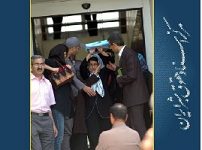Criminal Responsibility of Children in the Islamic Republic of Iran’s New Penal Code
By Mohammad H. Nayyeri
Attorney at Law, Iranian Bar Association
LLB, LLM, PhD Candidate, Tehran, Iran
LLM Human Rights, London, UK
According to international rules, including the Convention on the Rights of Child (CRC) and the Beijing Rules,[1] every human being under the age of eighteen years old is considered to be a child and shall not be subject to any criminal punishment. In fact, the criminal regime for children has been separated from that for adults—and the former has a supporting, correcting, and protecting character. It is also internationally accepted that neither capital punishment nor life imprisonment shall be imposed for offences committed by children.[2] The problem that arises in the Islamic Republic of Iran (IRI), and perhaps with other Islamic states, is the contradiction between, on the one hand, the internationally accepted notion of “child” and age of criminal responsibility and, on the other hand, the age of maturity under Islamic Shari’a.
In other words, internationally accepted standards, without any discrimination between boy and girl, have determined that the age of 18 is the standard age of entering into majority and full criminal responsibility. In Islamic sources, however, reaching the age of maturity is deemed to be the point of leaving childhood and becoming an adult which results in full criminal responsibility. Additionally, in none of the Islamic schools is the age of maturity under Islamic Shari’a law in complete conformity with the age of 18 as enshrined in international instruments and the age varies for boys and girls.
Before the adoption of the new Code, according to article 49 of the old Penal Code, “children” were exempted from criminal responsibility and, therefore, Correction and Rehabilitation Centers were in charge of correcting measures. However, ignoring the internationally accepted definition of the child, note 1 of the same article defined a child as an individual who has not reached the age of maturity under Islamic Shari’a. Nevertheless, the old Code was silent on how old is “the age of maturity under Islamic Shari’a”, and, in practice, it arguably referred back to the Civil Code.[3]
According to Islamic sources, the criterion for criminal responsibility is reaching the age of maturity which, according to the Shi’ite School in the IRI, is 9 lunar years (8 years and 9 months) for girls and 15 lunar years (14 years and 7 months) for boys. However, proving maturity even before the aforementioned ages is possible under Islamic Shari’a on the basis of other physical signs. For example it is possible that a boy under the age of 15 is deemed as having attained maturity under Islamic Shari’a, if he is capable of producing sperm.
Regarding the old Penal Code, there have been many legal and religious disagreements about the age of maturity and criminal responsibility. Some Islamic jurists held different views on the age of maturity—for example some proposed the age of 13 lunar years for maturity of girls. In addition, the majority of lawyers believed that recognition of criminal responsibility for a girl of 8 years and 9 months old and a boy of 14 years and 7 months old is wrong and violates international standards including the Convention on the Rights of Child and conflicts with the modern needs of society.
There has been also another criticism: while the minimum age for many legal affairs such as the application for a driver’s license, obtaining a passport, and/or signing a deed, etc. is 18 years old, and people under the age of 18 years old are not considered as meeting the physical, mental and rational requirements for these acts, those same people, if they commit a crime, will be treated as an adult with full criminal responsibility.
For this, the IRI has always been criticized by international bodies and in return it has tried to justify and deny the cases. To alleviate some of the criticism, the IRI has taken different measures—for example, it has often postponed the execution of the death penalty for juvenile convicts until they reach the age of 18. However, in some cases such considerations have been ignored completely and there is no room for any justification left. For instance, when a juvenile under the age of 18 is sentenced to the death penalty and executed before reaching the age of 18, there is no room left for denial and justification.[4]
Apparently, changes made in the new Penal Code are based on the same criticisms and international pressures. But one may ask whether these changes are real and whether the new Penal Code is a step forward? At first blush, what is striking is that the new Code includes an article that exempts immature children from criminal responsibility: according to article 146 “Immature children have no criminal responsibility”. Also, article 148 provides correctional and security measures for immature offenders.
In addition, contrary to the old Code, the new Penal Code has stipulated the age of maturity: article 147 fixes the age of 9 lunar years for girls and 15 lunar years for boys as the age of maturity. Therefore, the age of maturity under Islamic Shari’a is stipulated as the criterion for criminal responsibility and fatwas (i.e. religious opinions) which offer older ages are dismissed. So in fact, the hope that the minimum age of criminal responsibility is changed with time is lost.
On the other hand, while the old Code contained only two aforementioned articles dealing with the criminal responsibility of children and the special correctional and security measures that should apply to them, the new Code shows a special consideration to this matter and allocates articles 87 to 94 to the issue. The changes of the new Penal Code in this regard are very complicated and require deep analysis and scrutiny. The first point that needs to be explained is the categorization of children in the new Code under four groups, each subject to different rules:
- Children under 9 years old
- Children between 9 and 12 years old
- Children and juveniles between 12 and 15 years old
- Juveniles between 15 and 18 years old.
However, this categorization is only complete when combined with the categorization of crimes and punishments: 1-Hudud[5] 2-Qisas[6] 3-Ta’zir[7].[8] In addition, when hudud and qisas punishments are relevant, the maturity age is of importance. Therefore, the following eight situations are imaginable:
1- Children under 9 years old commit Ta’zir crimes: In such cases, there is no criminal responsibility, nor any correctional and security measures provided by law. Although the Code is silent on this, any other conclusion seems to be irrational. In this regard, there is no difference between girl and boy.
2- Children under 9 years old commit crimes punishable by Hudud and Qisas: In such cases, the gender of the child is of importance. If the child offender is a boy, considering that he has not reached the age of maturity, according to article 87, he shall be subject to minor correctional and security measures such as submission to his parents with promise of correction, sending the child to a social worker or psychologist, banning him from visiting specific persons or places, etc. If the child offender is a girl under 8 years and 9 months, she shall be treated the same. However, if she is a girl who has reached the age of maturity but she is under 9 years old (e.g. she is 8 years and 10 months), she may be subject to hudud and qisas punishments (which will be referenced in more details in situation No. 8 down below).
3- Children between 9 to 12 years old commit Ta’zir crimes: The court shall sentence this group of children to minor correctional and security measures such as submission to their parents with promise of correction, sending the child to a social worker or psychologist, banning them from visiting specific persons or places, etc. [For this category of crimes], there is no difference between girls and boys.
4- Children between 9 to 12 years old commit crimes punishable by Hudud and Qisas: In such cases, again, the gender of the child makes a huge difference. If the child offender is a boy, considering he has not reached the age of maturity, according to article 87, he shall be subject to minor correctional and security measures (see No. 2). However, if she is a girl, considering that girls in this age range have reached the age of maturity, she may be subject to hudud and qisas punishments (which will be referenced in more details in situation No. 8 down below).
5- Children and juveniles between 12 to 15 years old commit Ta’zir crimes: In the case of minor ta’zir crimes, the court’s decisions are similar to children of 9 to 12 years old (see No. 3). But, in the case of severe ta’zir crimes, the court may sentence the child to be held in a Correction and Rehabilitation Center from three months to one year. [For this category of crimes], there is no difference between girls and boys.
6- Children and juveniles between 12 to 15 years old commit crimes punishable by Hudud and Qisas: As stated above, when hudud and qisas punishments are concerned, the gender and the age of maturity remain important and make considerable differences. Thus, if the child offender is a boy who has not reached the age of maturity (14 years and 7 months), like severe ta’zir crimes (No. 5), he may be convicted to up to one year in Correction and Rehabilitation Center. However, if the child is a boy who has reached the age of maturity (e.g. 14 years and 9 months old), or if the child is a girl in this range of age (e.g. 13 years old), s/he may be subject to hudud and qisas punishments that are described in more detail below (see No. 8)
7- Juveniles between 15 to 18 years old commit Ta’zir crimes: In such cases, depending on the importance of the crime, the sentences may vary. But in the case of severe ta’zir crimes, the sentence is limited to a maximum of five years in a Correction and Rehabilitation Center. For minor ta’zir crimes, the sentence will not exceed more than 2 years in a Correction and Rehabilitation Center, public service and financial fines. In this respect, there is no difference between a girl and boy.
8- Juveniles between 15 to 18 years old commit crimes punishable by Hudud and Qisas: Considering article 90 and other articles of the Code, I have no doubt that in such cases, hudud and qisas punishments can be awarded. In other words, a juvenile between 15 to 18 years old, whether a boy or girl, has reached the age of maturity and bears criminal responsibility. Consequently, in the case of committing crimes punishable by hudud and qisas, s/he may be sentenced to such punishments. As mentioned above, on the issues of hudud and qisas, the Code still relies on the age of maturity under Islamic Shari’a. Therefore, if a boy—after reaching the age of 15 lunar years (14 years and 7 months)—and a girl—after reaching the age of 9 years (8 years and 9 months)—commit crimes punishable by hudud and qisas, they may not be sentenced to correctional and security measures, but instead may be subject to hudud and qisas rules and will be treated as adults.
However, article 90 of the new Code, may, in special conditions, exempt such children and juveniles from hudud and qisas punishments and provide correctional and security measures instead:
Article 90 – In respect of crimes punishable by hudud and qisas, if the offenders, who are under 18 years old but have reached the age of maturity, do not understand the nature of the committed crime or its prohibition, or if there is a doubt about their mental development and perfection, then, according to their age, they shall be awarded one of the punishments provided in this chapter.
Note – In recognizing the mental development and perfection, the court may ask for the opinion of Forensic Medicine or employ other means which it deems appropriate.
Therefore, when, for example, a 17 year old boy or girl commits a murder, if according to the opinion of the judge, s/he understands the nature of the crime, and, Forensic Medicine confirms his/her mental development, subject to other conditions, s/he may be sentenced to qisas (i.e. the death penalty). So, contrary to what the spokesperson of the Judicial and Legal Commission of the IRI Parliament asserted,[9] and unfortunately what was accepted and distributed by the media, qisas punishment for people under 18 years old has not been abolished and is still a strong prospect for such offenders. Similarly, in the case of hudud crimes such as an illicit sexual relationship (zena), sodomy (levat), homosexual behavior between girls (musaheqeh), etc. it is still possible for child and juvenile offenders to be sentenced to violent and inhumane punishments such as the death penalty, stoning to death, flogging, etc. Moreover, this MP’s assertion about the lack of gender discrimination in relation to hudud and qisas, is not true at all.
Conclusion
It is not deniable that according to the new Code, there have been some desirable changes in respect to ta’zir punishments. As a result, children, if they commit ta’zir crimes before turning 18 years old, whether they are boys or girls, and whether they have reached the age of maturity or not, shall be sentenced merely to correctional and security measures. So, there is no possibility for application of adult ta’zir punishments on children and juveniles. In comparison with the old Code, in which reaching the age of maturity resulted in full criminal responsibility, these changes may be regarded as positive, especially for girls. In addition, the possibility of averting hudud and qisas in a situation in which a lack of mental development is proved is another positive change, though this is arguable and does not completely solve the problem.
However, it should not be forgotten that the reform which has always been encouraged by human rights activists and international bodies, is the complete abolition of the death penalty and qisas and violent punishments, without ifs and buts, for all people under 18 years old, which is not the reform taken here. Therefore, the bold assertions of the spokesperson of the Judicial and Legal Commission of the IRI Parliament that qisas and the death penalty for people under 18 years old is prohibited in the new penal code, are not acceptable. The way the related articles are stated in the new Code is rather to cause jugglery and dishonesty, and, assertions made by this MP pursue the same goal of distracting the minds. Using the solar year metric instead of the lunar year when dealing with the correctional measures on the one hand whilst entering the notion of maturity under Islamic Shari’a in the definition of children and juveniles on the other hand, in fact creates a loophole for hiding the bloody rules of hudud and qisas inside correctional and security measures designed specifically for children.
I stress again that, under the new Penal Code, there remains the possibility of the application of hudud and qisas punishments on people under 18 years old, and, obviously it has not been abolished. In addition, contrary to some assertions, the new Code, like the old one, clearly discriminates between boys and girls. The IRI authorities, however, try to introduce these inhumane and discriminatory rules as progressive ones and in conformity with international standards! The truth is that the IRI is far from meeting international standards on the rights of the child and nothing is gained through such lacking and deceitful efforts.
[1] United Nations Standard Minimum Rules for the Administration of Juvenile Justice
[2] Paragraph (a) of article 37 of the Convention on the Rights of Child
[3] Note 1 of article 1210
[4] For example, Alireza Mullah Soltani, born in December 1993, was hanged on September 21, 2011, in retribution (Qisas) for the murder of Ruhollah Dadashi. Human rights activists objected to the execution of the 17 year old minor and the Islamic Republic of Iran was criticized for killing underage criminal offenders. (link: http://www.en-hrana.org/index.php?option=com_content&view=article&id=521:17-year-old-alireza-mullah-soltani-hanged&catid=10:children&Itemid=8)
[5] Crimes punishable by hadd (pl. hudud) are those with fixed and severe punishments in Islamic sources. These include crimes such as illicit sex, sodomy, homosexual behavior between women, consumption of intoxicants, muharebeh, etc. and are punishable by the death penalty, stoning to death, amputation of the right hand and the left foot, flogging, etc.
[6] Crimes punishable by Qisas (retribution) are a category of crimes under Islamic criminal law which are best illustrated by the old maxim “An eye for an eye, a tooth for a tooth, and a life for a life”.
[7] Crimes punishable by ta’zir are those for which punishments are not fixed and instead are left to the discretion of the Shari’a judge. However, almost all ta’zir crimes are dealt with in the Penal Code and the judge may apply the punishments in the Code. They include the rest of the crimes rather than hudud and qisas.
[8] There is another category (Diya) which deals with financial compensation for bodily harms and injuries. But, as it plays no important role in this specific discussion and violent punishments for children, it is not mentioned here.
[9] For example, the newspaper Donya-ye-Eqtesad, in its February 12, 2012 edition, in a piece titled “Prohibition of Qisas Punishment for People under 18 Years Old” stated: “Spokesperson of Judicial and Legal Commission of Parliament stressed that, by passage of the new Islamic Penal Code, qisas punishment for people less than 18 years old is prohibited. Amin Hossein Rahimi, in respect to the recent changes in the Penal Code, declared: the age of criminal responsibility in the old Penal Code was 9 and 15 lunar years which were different between girls and boys and the age of maturity under Shari’a was the criterion. But, in the new Code, we defined the age of criminal responsibility in a way that girls and boys under 18 years old are considered as children and juvenile and the punishments of adults are not applied on them anymore. This MP, in response to the question of whether these offenders will be punished after reaching the age [of 18] like in the past, said no. Before the age of criminal responsibility was 9 and 15 years, but now, if the offender is under 18 years old, he/she shall be sent to Correction and Rehabilitation Center”. Link: http://www.donya-e-eqtesad.com/Default_view.asp?@=289512







